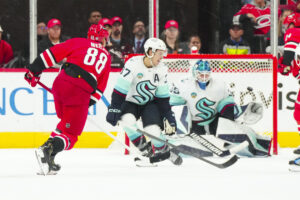In Part 1 of our series, we reviewed much of San Jose Sharks general manager Doug Wilson and his history with the Sharks. In this part, we’ll look at the three decisions Wilson made which created the team’s core.
Doug Wilson and Three Transformative Decisions
Doug Wilson made three decisions early in his general manager tenure which formed the core Sharks built their success around.
In his first entry draft, he acquired three respectable players in early rounds. But in the seventh round, he hit the home run he didn’t hit in earlier rounds. He drafted Joe Pavelski.
Later in 2003, Wilson traded away goalie Miikka Kiprusoff for a second-round pick in the 2005 draft. The pick, 35th overall, was used to select Marc-Edouard Vlasic, the next important piece.
Wilson’s third critical move came in late November of 2005 when the team traded for Joe Thornton.
The trio of Thornton, Pavelski and Vlasic would deliver elite season after elite season. The Sharks had the league’s best shutdown defenceman in Vlasic, a first-ballot Hall of Fame centre in Thornton and a high-end jack-of-all-trades player in Pavelski. From the time they first hit the ice together in 2006 until the end of their elite road in April 2017, each delivered a triple-digit plus rating.
Of the three, Pavelski was the most clutch, Thornton the best and Vlasic the most important. They were durable, smart and a constant problem for opponents.
It is worth mentioning one other important point. The trio was mostly paid at or below fair value over the course of these years, providing not just superb play, but superb play at a reasonable price.
Around the Core
Wilson complemented this trio with talent acquired before his arrival (Patrick Marleau, Douglas Murray, Ryane Clowe, Evgeni Nabokov), then added talented veterans (Dan Boyle, Brent Burns) to keep the roster competitive.
The Sharks not only had a strong trio at the core but also additional high-end contributors. The Sharks were a dangerous team at the top end and this extended to the middle of the line-up.
Wilson added plenty via lesser trades. Several required shipping out first-round picks, often attempting to find the one extra element which might bring home a Cup.
Wilson’s talent acquisitions came at a price. Boyle and Burns would cost the Sharks first-round picks. They’d become long-tenured members of the team. Brian Campbell and Craig Rivet also cost first-round picks, both had short tenures. More recently, Wilson traded away first-round picks, first for Evander Kane and six months later, for Erik Karlsson. The Karlsson trade cost the Sharks dearly, including the third overall pick in the most recent draft. It would have been the highest draft pick in the Wilson era.
Doug Wilson Trading Picks, Missing Picks
Trading in and around the draft has been a signature of Wilson’s. For his first draft in 2003, Doug Wilson made seven trades in three days prior to and during the draft. In the most recent draft, Wilson drafted nine players. All nine selections were picks acquired by trade. All seven of the original draft slots were traded away. Even though the Sharks wound up with more picks, they’d effectively traded down.
In all, Wilson has had 15 first-round selections and 18 second-round selections (four in the past two drafts). And while some have panned out, the recent miss ratio is simply too high. Beginning with the 2008 draft, only two first-round picks and two second-round picks became something other than a fourth-line forward or third-pair defenceman for the Sharks.
Still, Wilson did overachieve at times, including two very strong Calder Trophy candidates. Logan Couture finished second in his rookie season (and probably deserved better). Tomas Hertl was on his way to lapping the Calder field until his knee injury in game 35. Ten of the last 15 Calder winners have been top five selections (something Wilson has never had), yet Wilson was able to find deserving players picked ninth and 17th overall.
Grading the Picks
Of Wilson’s first-round picks, five can be safely called busts (though he did get some value back in trades for some of these). Two first-round picks are with the Sharks are in their development phase. And eight turned into pretty good, or very good, NHL players.
In round two, it is six hits, seven misses and five in the ‘too early to say’ category. Round 3, though, it is ugly. Only one player has done anything meaningful in the NHL, Thomas Greiss. And he only played 44 games for the Sharks before departing as a free agent.
Wilson’s draft record is mixed. Not as bad as some might think. But with too many misses with high picks, he deserves a modest grade.
Injury Misfortunes
Three Sharks first-round selections dealt with injuries that may have altered promising careers. And the team’s Stanley Cup chances.
The first major injury to derail Wilson’s Sharks came quickly. His very first draft selection was also his highest pick, sixth overall. Milan Michalek took the ice for his NHL debut at the start of the 2003-04 season. He scored a goal in his first game and tore his ACL in his second. He’d injure the same knee again and miss two seasons before he played his third NHL game. Whether Michalek ever reached the form he might have otherwise achieved is up for debate. But he didn’t live up to what was hoped for from such a high pick.
Wilson inherited winger Jonathan Cheechoo. In the 2003-2004 season, Cheechoo showed goal-scoring promise, potting 28 goals at age 23. It’s one thing to be a natural goal scorer, but another to be a natural goal scorer on Joe Thornton’s wing. At age 25, he delivered a league-leading 56 goals. Alas, injuries crept in and Cheechoo’s numbers declined each season from there. Just three seasons later, in what should have been the prime of his career, he netted just 12 goals. His once-promising NHL career ended at age 29.
Later On
A full decade of a healthy Michalek and Cheechoo might well have gotten the Sharks a Stanley Cup. But it wasn’t to be.
The third first-round pick to suffer from serious injuries is Tomas Hertl. Cruising to the rookie of the year, Hertl had 15 goals and his 12 even-strength tallies in 34 games were just four less than Calder winner Nathan MacKinnon‘s 82 game total. In game 35, Hertl’s knee gave out in a controversial knee-on-knee collision with Los Angeles Kings forward Dustin Brown. As with Michalek and Cheechoo, Hertl’s health has been up and down over his career. Most notably, after an effective but somewhat unlucky performance in the 2016 Stanley Cup Final (hitting the post three times in one game), Hertl’s knee gave out and he missed the final four games of the series. It was a significant blow for a Sharks team. Hertl was the one player the Pens had no good answer for.
The Doug Wilson Window
The Sharks Stanley Cup window was open as long as the trio of Pavelski, Vlasic and Thornton remained high performers. In 2016, Vlasic, Thornton and Pavelski were all still elite. Still, Wilson saw the Stanley Cup window closing and expected the first player to exit elite status to be the oldest, which was Thornton. Wilson plotted his next move carefully. He spent nearly two seasons, likely beginning in 2016 or early 2017, carefully managing the salary cap so when the opportunity arose, he could strike.
Opportunity had a name: John Tavares. Here was a great player mired on mediocre New York Islanders teams. San Jose had much of what Tavares’ career had lacked. He could step into the giant skates Thornton occupied, an elite centre surrounded by an above-average supporting cast. He could step into a culture accustomed to winning, to making the playoffs. And he could come to an area where players loved to play and where numerous Canadians found themselves comfortable not just playing, but also retiring. To be blunt, Doug Wilson had the right player, the right fit and a darn good sales pitch.
Wilson went all in. And on July 1, 2018, he missed. Perhaps he hadn’t counted on Tavares wearing Toronto Maple Leaf pyjamas when he was a kid, but that’s where the player’s heart was and that’s where he went. The window was closing, and faster than Wilson had hoped.
Three, Two, One, Zero
Beginning in 2017, April 2 to be specific, the trio which formed the Sharks core began to disappear. On that day, Thornton tore knee ligaments; his days as an elite centre ended.
In July 2017, Vlasic signed an eight-season deal with the Sharks. It took effect beginning with the 2018-19 season. This is also when Vlasic’s game declined substantially. Another piece missing.
Pavelski, the lone remaining high-end player of Wilson’s core, left via free agency following the 2018-19 season.
The trio that formed the Sharks core was no longer the core. One left by injury, one left in free agency, one left with a major decline in his game. The Sharks reached an inflection point.
An era ended. Another had begun. We’ll cover this in the third and final part of the series.
Main Photo:
Embed from Getty Images






